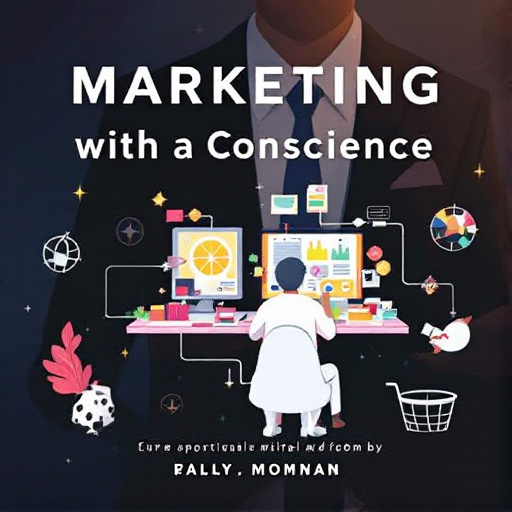Featured Articles
- 12 Innovative Guerrilla Marketing Tactics to Explode Your Brand Visibility Without Breaking the Bank
- How Sensory Branding Taps Smells and Sounds to Forge Deeper Emotional Bonds with Customers
- Marketing with a Conscience: How Brands are Embracing Ethical Dilemmas to Drive Consumer Loyalty
- The Rise of Eco-Conscious Branding: Turning Green Ethics into Marketing Gold
- The Surprising Role of Memes in Shaping Modern Brand Strategies: A New Frontier in Business Marketing
The Rise of Eco-Conscious Branding: Turning Green Ethics into Marketing Gold
The Rise of Eco-Conscious Branding: Turning Green Ethics into Marketing Gold
Eco-conscious branding is not just a trend—it's a movement that transforms ethical practices into profitable business opportunities. As consumers increasingly demand sustainability, brands that align themselves with green ethics are finding success in the market.
The Shift in Consumer Mindset
In the past decade, there has been a seismic shift in how consumers view brands and their ethics. A 2021 study by Nielsen found that 73% of global consumers are willing to change their consumption habits to reduce their environmental impact (Nielsen). This escalated awareness has birthed a new breed of consumer—one that actively seeks brands with sustainable practices.
The Power of Authenticity
Authenticity is key in eco-conscious branding. Brands that genuinely invest in sustainable practices rather than simply hopping on the “greenwashing” bandwagon are reaping the rewards. For instance, Patagonia Inc., an outdoor apparel company, has established itself as a leader in sustainable branding by pledging 1% of sales to environmental causes and being transparent about their supply chain.
Case Study: Patagonia
Founded in 1973, Patagonia has woven environmental activism into the very fabric of its brand. In 2022, the company reported a record $1 billion in sales, an impressive figure that proves that commitment to social and environmental values can lead to sizable financial gains. Their “Don't Buy This Jacket” campaign, encouraging customers to think before buying, didn’t hurt either—it surprisingly boosted sales as customers appreciated the brand’s honesty.
The Role of Digital Marketing
In today's digital landscape, social media serves as both a powerful tool for spreading awareness and a platform for engaging with eco-conscious consumers. Brands that focus on storytelling can connect with their audience on a more personal level. For example, Warby Parker, known for its stylish eyewear, has adopted a “Buy a Pair, Give a Pair” initiative. Through social media channels, they share stories of how they’ve made a difference in underprivileged communities, which resonates with the socially conscious buyer.
Creative Storytelling: Engaging the Eco-Conscious Consumer
Did you hear about the shoe company that planted a tree for every pair sold? Okay, it’s not just a good line at a cocktail party—it’s the premise of TOMS Shoes. By integrating philanthropy into their business model, TOMS has forged a community of buyers eager to support a brand that gives back. This kind of marketing isn’t just about pestering consumers with ads; it’s about crafting a narrative that consumers want to be part of.
Statistics That Speak Volumes
A report from Gartner revealed that 72% of marketing executives believe that sustainability will be a cornerstone of marketing by 2025. This indicates a shift not just in consumer behavior, but also in the way brands are planning their marketing strategies. Capitalizing on this trend while being genuine can lead to marketing gold.
The Risks of Greenwashing
While eco-conscious branding can yield exponential benefits, there is an inherent risk in falling into the trap of greenwashing—falsely marketing products as environmentally friendly. A study published in the *Journal of Business Research* found that brands that engage in greenwashing suffer a significant drop in customer trust, leading to long-term harm to their reputation. Brands like Volkswagen, which faced backlash for their emissions scandal, demonstrate just how destructive this can be.
Humor: A Gentle Reminder Not to Mess Up
Imagine marketing a cow’s milk carton that promises to be “gluten-free” or “non-GMO.” While it might generate a laugh, it’s a bizarre example of how easy it is to miss the mark. When brands make exaggerated claims about sustainability, consumers don’t just scratch their heads—many take to social media faster than you can say “eco-conscious.” Trust me, you don’t want your brand’s hashtag to trend for the wrong reasons!
Building a Sustainable Brand: Practical Steps
So, how can businesses integrate eco-conscious principles effectively? Here are a few practical steps:
- Evaluate Your Supply Chain: Look for local suppliers who engage in sustainable practices, reducing carbon emissions from transportation.
- Use Sustainable Materials: Switch to sustainable raw materials that reduce your brand’s environmental footprint.
- Commit to Transparency: Keep consumers informed about your sustainability goals and practices, inviting them on the journey with you.
- Engage in Community Initiatives: Partner with organizations working towards environmental conservation.
The Millennial Factor
Did you know that millennials and Gen Z make up a substantial portion of current consumers? According to a report from IBM, 62% of Gen Z want to work for a company whose values align with theirs. Brands that miss the eco-conscious boat might find themselves sinking fast, as younger consumers lead the charge toward a more sustainable world.
Building a Community Around Your Brand
Community is pivotal for an eco-conscious brand. Engaging your audience beyond transactional interactions creates deeper connections. Brands like The Body Shop build loyal customer bases by creating initiatives such as "Community Fair Trade," which allows consumers to directly connect and contribute to the lives of the farmers and communities who provide their ingredients.
Conclusion: The Future is Green
In summary, the rise of eco-conscious branding is more than just a marketing strategy; it represents a fundamental shift in consumer values and expectations. As brands like Coca-Cola pivot towards sustainability in their packaging (aiming for 100% recyclable materials by 2025), we can expect sustainability to become a core tenet in marketing strategies. Embracing green ethics isn’t only the right choice; it’s becoming a crucial component of successful branding.
So, whether you're an aspiring entrepreneur or a seasoned marketer, remember: the future is green, and it’s time to turn those green ethics into marketing gold!



